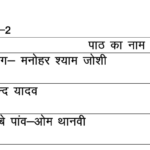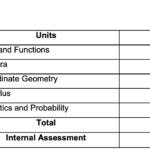The Uttarakhand Board of School Education (UBSE) has released the updated Maths syllabus for Class 12 students for the academic year 2024-2025. This syllabus is designed to provide a comprehensive understanding of mathematical concepts that are essential for higher education and various competitive exams.
Check UK board 12th maths syllabus and XII mathematics Uttarakhand board exam pattern with list of internal assessments and activities.
Contents
Uttarakhand Board 12th Maths Syllabus 2024-2025

Unit-I: Relations and Functions
Chapter 1: Relations and Functions:- Types of relations: reflexive, symmetric, transitive and equivalence relations. One to one and onto functions.
Chapter 2: Inverse Trigonometric Functions:- Definition, range, domain, principal value branch. Graphs of inverse trigonometric functions.
Unit-II: Algebra
Chapter 3: Matrices:- Concept, notation, order, equality, types of matrices, zero and identity matrix, transpose of a matrix, symmetric and skew symmetric matrices. Operations on matrices: Addition and multiplication and multiplication with a scalar. Simple properties of addition, multiplication and scalar multiplication. Non-commutativity of multiplication of matrices and existence of non-zero matrices whose product is the zero matrix (restrict to square matrices of order 2). Invertible matrices and proof of the uniqueness of inverse, if it exists; (Here all matrices will have real entries).
Chapter 4: Determinants:- Determinant of a square matrix (up to 3 x 3 matrices), minors, co-factors and applications of determinants in finding the area of a triangle. Adjoint and inverse of a square matrix. Consistency, inconsistency and number of solutions of system of linear equations by examples, solving system of linear equations in two or three variables (having unique solution) using inverse of a matrix.
Unit-III: Calculus
Chapter 5: Continuity and Differentiability:- Continuity and differentiability, chain rule, derivative of inverse trigonometric functions, sin−1, cos−1 and tan−1 , derivative of implicit functions. Concept of exponential and logarithmic functions. Derivatives of logarithmic and exponential functions. Logarithmic differentiation, derivative of functions expressed in parametric forms. Second order derivatives.
Chapter 6: Applications of Derivatives:- Applications of derivatives: rate of change of quantities, increasing/decreasing functions, maxima and minima (first derivative test motivated geometrically and second derivative test given as a provable tool). Simple problems (that illustrate basic principles and understanding of the subject as well as real- life situations).
Chapter 7: Integrals:- Integration as inverse process of differentiation. Integration of a variety of functions by substitution, by partial fractions and by parts, Evaluation of simple integrals of the following types and problems based on them.

Fundamental Theorem of Calculus (without proof). Basic properties of definite integrals and evaluation of definite integrals.
Chapter 8: Applications of the Integrals:- Applications in finding the area under simple curves, especially lines, circles/ parabolas/ ellipses (in standard form only)
Chapter 9: Differential Equations:- Definition, order and degree, general and particular solutions of a differential equation. Solution of differential equations by method of separation of variables, solutions of homogeneous differential equations of first order and first degree. Solutions of linear differential equation of the type:

Unit-IV: Vectors and Three-Dimensional Geometry
Chapter 10: Vectors:- Vectors and scalars, magnitude and direction of a vector. Direction cosines and direction ratios of a vector. Types of vectors (equal, unit, zero, parallel and collinear vectors), position vector of a point, negative of a vector, components of a vector, addition of vectors, multiplication of a vector by a scalar, position vector of a point dividing a line segment in a given ratio. Definition, Geometrical Interpretation, properties and application of scalar (dot) product of vectors, vector (cross) product of vectors.
Chapter 11: Three – dimensional Geometry:- Direction cosines and direction ratios of a line joining two points. Cartesian equation and vector equation of a line, skew lines, shortest distance between two lines. Angle between two lines.
Unit-V: Linear Programming
Chapter 12: Linear Programming:- Introduction, related terminology such as constraints, objective function, optimisation, graphical method of solution for problems in two variables, feasible and infeasible regions (bounded or unbounded), feasible and infeasible solutions, optimal feasible solutions (up to three non-trivial constraints).
Unit-VI: Probability
Chapter 13: Probability:- Conditional probability, multiplication theorem on probability, independent events, total probability, Bayes’ theorem, Random variable and its probability distribution, mean of random variable.
UK Board 12th Mathematics Practical Assessment (Activities) 2024-2025

- Assessment of Activity Work:- Throughout the year any 10 activities shall be performed by the student from the activities given in the NCERT Laboratory
- Manual for the respective class (XI or XII) which is available on the link: http://www.ncert.nic.in/exemplar/labmanuals.html
- A record of the same may be kept by the student. At the end of year, a test on the activities may be conducted.
More Links For UBSE Class XII Syllabus 2024-25
| Subject Name (12th) | Subject Code | Syllabus Link |
| 12th Maths | 128 | CLICK HERE |
| 12th Physics | 129 | CLICK HERE |
| 12th Chemistry | 130 | CLICK HERE |
| 12th Biology | 131 | CLICK HERE |
| 12th Hindi | 101 | CLICK HERE |
| 12th English | 103 | CLICK HERE |
| Latest UBSE Updates | UBSE | CLICK HERE |
| UK Board Class 12th All Subjects Syllabus |
All Subjects | CLICK HERE |
| Official Website | UK Board | CLICK HERE |
Important FAQS
How should students prepare for the UK Board 12th Maths exam?
Students should focus on understanding the fundamental concepts of each topic, practice regularly with a variety of problems, and review previous years' question papers to get familiar with the exam pattern. Time management and regular revision are also crucial for effective preparation.
What is the exam pattern for the UK Board 12th Maths paper?
The Maths exam typically consists of both objective and subjective questions. The paper is designed to test students' understanding, problem-solving abilities, and application of mathematical concepts. The exact distribution of marks across different sections may vary, so students should refer to the official guidelines. 80 marks of subjective paper with 20 marks of internal assessments.
Where can students find the official UK Board 12th Maths syllabus for 2024-2025?
All subject syllabus links are given on this page. You can also open UBSE official website.






![UK Board Class 11th Biology Syllabus 2024-2025 [XI UBSE Uttarakhand] feature image](https://4syllabus.in/wp-content/uploads/2024/09/UK-Board-Class-11th-Biology-Syllabus-2024-2025-XI-UBSE-Uttarakhand-feature-image-150x150.webp)
